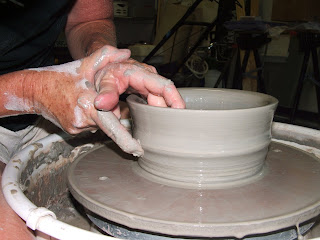
The first step is kneading the clay to make it pliable and remove any air bubbles. She uses a variety of clays, some dark, red, white, or speckled.

Next, she makes it roughly circular and places it on a bat (the flat plate) on her wheel.

Then, using a good bit of water and a very fast spinning wheel, she uses her hands and her body weight to lean over the wheel and center the clay into the middle.


You can see how fast the wheel is spinning by the amount of water being sprayed out in this shot. It can take a few minutes to get the clay centered, but it's so important to make sure the bowl comes out round : ) And as I've found in my few attempts, it can be the most frustrating and time consuming part of the process : )
Next, she uses a thumb and two fingers to gently press down and form the center. The wheel is spinning about a medium speed or whatever she feels comfortable with.
After the center is large enough, she takes a flat edged tool to smooth the bottom and compress the clay.
Now she's ready for the first "pull." Using the sponge on top for counter pressure, she "digs in" with her thumb at the bottom of the outside edge, and gradually pulls up the clay from the bottom.
After that first pull using the thumb, she changes her grip and uses her forefinger on the outside and middle fingers for balance on the inside. This continues to draw up clay from the bottom toward the top.
She can continue to pull the clay several times until she feels she's done enough and it's no longer thick at the bottom.
Then she uses a thin metal tool to smooth the inside and out, removing the slip (or the wet clay that can cause the bowl to sag). This smooths it and gets it ready for the next step.

That same metal tool, along with counter pressure from the sponge, allows her to continue to shape the bowl by pushing out the sides as the wheel spins.
Once it is flared out far enough, she can use the sponge to smooth out the rim and give it its final shape.
Next step will be trimming, carving, and the first firing....stay tuned.












No comments:
Post a Comment